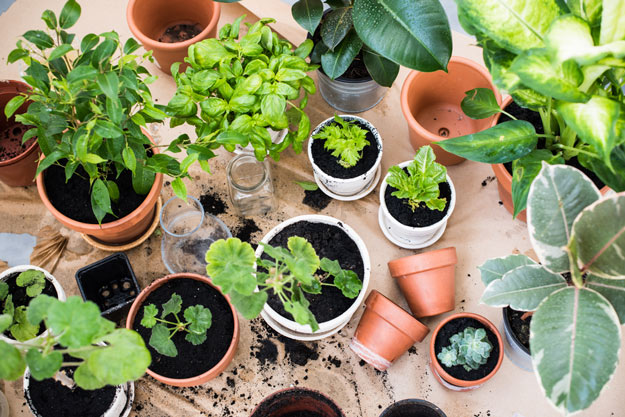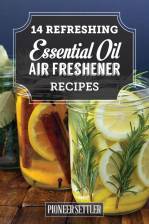Want to know what air purifying plants you can put in your home? The rocket scientists at NASA recommend these fine plant specimens for your care and comfort.

NASA's Guide to Air Purifying Plants
Air pollution is every where. That's one of the reasons why I seldom leave the comforts of my homestead. Can you imagine trading fresh clean air to air that's polluted with smoke and toxins? I know I can't. I love my homestead and I really wish I could share the fresh air I'm breathing with all of you. I know that may not be possible, especially if you live in the big city.
Never fear – NASA has provided a wonderful solution here. Clean up your air with these healthy plants. They absorb the toxins and emit fresh clean oxygen for you to enjoy.
|
The NASA Guide to Air-Filtering Houseplants
It won't surprise you to hear that the majority of people spend the bulk of their time indoors, whether it's a home or working in an office environment. As such, it's important to ensure that the air quality is of a high standard, something that regular houseplants can help achieve. Back in 1989, NASA conducted a Clean Air Study in association with Associated Landscape Contractors of America, in an effort to find the most effective common indoor plants for filtering harmful toxins and pollutants from the air. Their results have stood the test of time, and the most effective air filtering plants can be found below.
What Pollutants Are in Our Air and How Do They Effect Me?
Like most chemicals, the adverse health effects you may encounter depend on several factors, including the amount to which you are exposed, the way you are exposed, the duration of exposure and the form of the chemical. Below are common symptoms associated with each toxic agent.
Trichloroethylene
Found in printing inks, paints, lacquers, varnishes, adhesives and paint remover/stripper.
How does Trichloroethylene effect me?
Symptoms associated with short term exposure include excitement, dizziness, headache, nausea and vomiting followed by drowsiness and coma.
Formaldehyde
Found in paper bags, waxed papers, facial tissues, paper towels, table napkins, particle board, plywood paneling, and synthetic fabrics.
How does formaldehyde effect me?
Symptoms associated with short-term exposure include irritation to nose, mouth and throat, and in severe cases, swelling of the larynx and lungs.
Benzene
Used to make plastics, resins, synthetic fibers, rubber lubricants, dyes, detergents, drugs and pesticides. Can also be found in tobacco smoke, vehicle exhausts, glue, paint, and furniture wax.
How Does Benzene Effect Me?
Symptoms associated with short term exposure include irritation to eyes, drowsiness, dizziness, increase in heart rate, headaches, confusion and in some cases can result in unconsciousness.
Xylene
Found in printing, rubber, leather and paint industries, tobacco smoke and vehicle exhausts.
How Does Xylene Effect Me?
Symptoms associated with short term exposure include irritation to mouth and throat, dizziness, headache, confusion, heart problems, liver and kidney damage and coma.
Ammonia
Found in window cleaners, floor waxes, smelling salts and fertilizers.
How Does Ammonia Effect Me?
Symptoms associated with short term exposure include eye irritation, coughing and sore throat.
Click here for sore throat remedies.
Air-Filtering Plants

Please note: Several of these plants are known to be toxic to cats, dogs and other pets. If you are a pet owner, please do check the toxicity of plants before introducing them to your home.
- Dwarf Date Palm (Phoenix robelenii)
- Boston Fern (Nephrolepis exaltata)
- Kimberley Queen Fern (Nephrolepis obliterata)
- Spider Plant (Chlorophytum comosum)
- Chinese Evergreen (Aglaonema modestum)
- Bamboo Palm (Chamaedorea seifrizii)
- Weeping Fig (Ficus benjamina)
- Devil's Ivy (Epipremnum aureum)
- Flamingo Lily (Anthurium andraeanum)
- Lilyturf (Liriope spicata)
- Broadleaf Lady Palm (Rhapis excelsa)
- Barberton Daisy (Gerbera jamesonii)
- Cornstalk Dracaena (Draceaena fragrans ‘Massangeana')
- English Ivy (Hedera helix)
- Varigated Snake Plant (Sansevieria trifasciata ‘Laurentii')
- Red-edged Dracaena (Draceaena marginate)
- Peace Lily (Spathiphyllum ‘Mauna Loa')
- Florist's Chrysanthemum (Chrysanthemum morifolium)
Does this make you want to add one or some of these air-filtering houseplants? Let us know which ones below in the comments!


Found another interpretation of the NASA study. https://keepairpure.com/the-nasa-guide-to-air-filtering-houseplants/
Short-term exposure symptoms include nose, mouth, and throat discomfort, and in extreme cases, laryngeal and pulmonary edema.